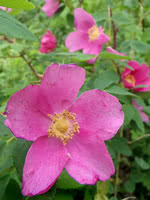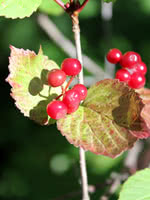Mon-Fri 9am - 5pm Mountain time
Hedge Rose vs Lowbush Cranberry
Rosa rugosa x Rosa woodsii (Improved hybrid developed by PFRA)
Viburnum edule
NOT AVAILABLE THIS SEASON - MIGHT RETURN
Hedge Rose is a long-lived, fast-growing shrub. It bears similar flowers to the Alberta Wild Rose. Birds will love its deep red rose hips. Hedge Rose will thrive in a wide variety of soils and is a tall rose forming a useful hedge.
Excellent for shelterbelts, ecobuffers, and wildlife habitat plantings. Continuous flowering makes it attractive to pollinators. Many song and game birds utilize this tree for food and habitat.
In use since the early 1900s, this hybrid was originally developed at the PFRA's Indian Head Agroforestry Center.
Lowbush Cranberry is a short, deciduous shrub native to North America. Its white flowers bear sour but edible fruit that ripens to a brilliant red in fall. Lowbush Cranberry's small size makes it suitable for urban use; buyers will also find it useful if trying to reclaim land back to its original species or when landscaping with native species in damp conditions.
Hedge Rose Quick Facts
Lowbush Cranberry Quick Facts
In row spacing: 0.3 m (1.0 ft)

